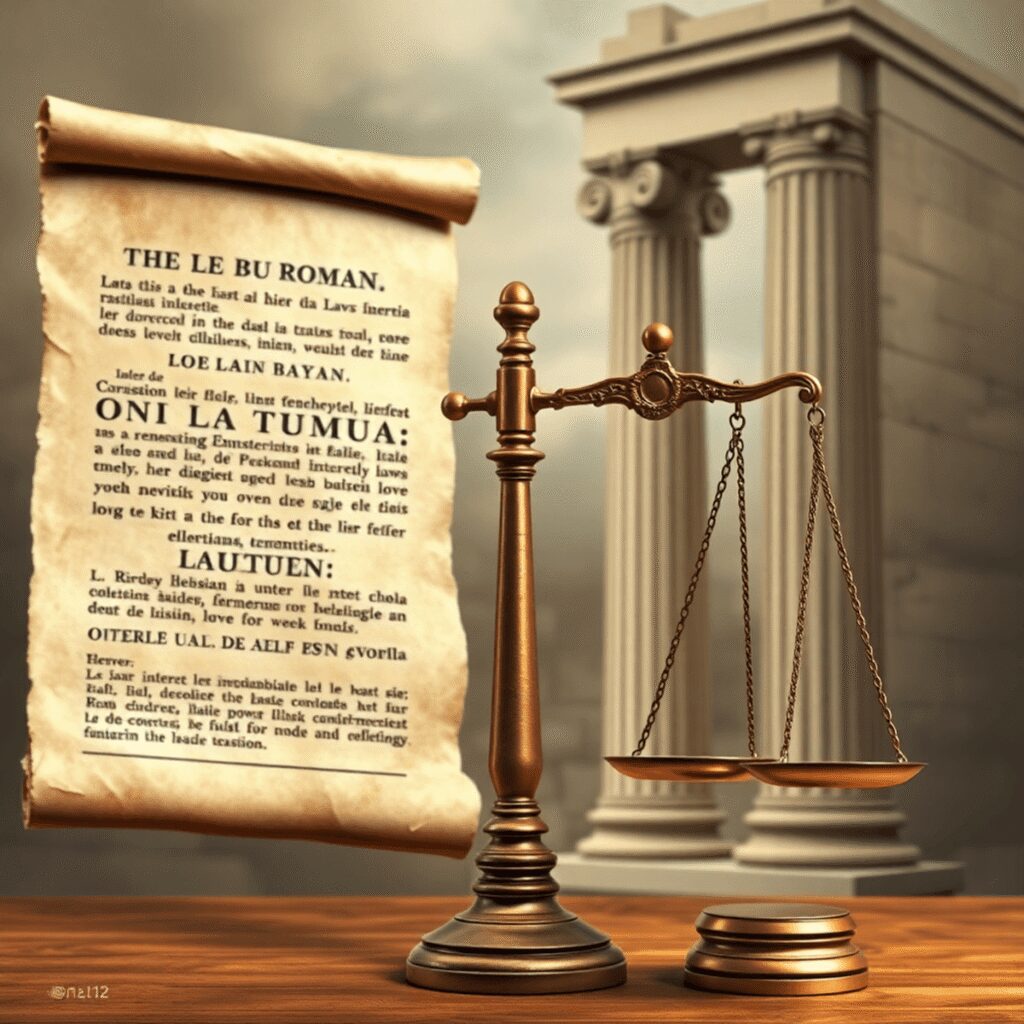Roman law, originating in ancient Rome, has significantly shaped modern legal systems globally. Its influence spans centuries and continents, laying down foundational principles that continue to resonate today.
This article delves into the historical development of Roman law, exploring its core principles that endure in contemporary legal frameworks. By examining its impact on civil law systems worldwide and its contributions to legal institutions and governance, we aim to highlight the enduring legacy of Roman law on today’s legal landscape.
Historical Development of Roman Law
The development of Roman law can be traced back to the foundational document known as the Twelve Tables, which marked Rome’s initial attempt at codifying its laws. This early codification set the stage for the evolution of Roman legal principles over the centuries.
Categories of Law in Ancient Rome
Ancient Rome distinguished between two main categories of law:
- Written Law (jus scriptum): Refers to laws that were explicitly recorded and documented, providing a clear framework for legal proceedings.
- Customary Law (jus non scriptum): Represented unwritten traditions and practices that held significant weight in legal matters alongside written laws.
Evolution of Roman Law
As Roman society progressed, so did its legal system, with subsequent codifications and legal interpretations shaping the landscape of Roman law. Different emperors and jurists contributed to this evolution by refining existing laws and introducing new legal concepts to adapt to the changing needs of society.
Influence of Roman Law
Through these continuous developments, Roman law solidified its position as a sophisticated and comprehensive legal system that influenced not only its contemporary societies but also laid the groundwork for future legal systems around the world. This extensive impact is part of the legacy of Ancient Rome, which remains a cornerstone of Western civilization.
While exploring the fascinating world of Ancient Rome, one can’t help but acknowledge how entertainment in ancient Rome was a crucial part of society. Various activities like gladiator fights, chariot races, and theatrical performances not only fascinated the people but also had significant effects on social relationships and political authority.
Moreover, it’s interesting to note that during this period, philosophical schools such as Stoicism gained popularity. Founded by Zeno of Citium around 300 BCE in ancient Greece, Stoicism emphasized living in harmony with nature, using reason, and practicing virtue as paths to achieving eudaimonia, or human flourishing. These ideas significantly influenced Roman culture and thought.

Core Principles of Roman Law That Endure Today
Roman law laid the groundwork for several core principles that continue to shape modern legal systems worldwide. These enduring concepts include:
1. Property Ownership and Transfer
Roman law established fundamental principles regarding property rights, ownership, and transfer. The Roman legal system recognized the importance of clear property rights, which are essential for economic transactions and societal organization. Today, the concept of property ownership and transfer continues to be a cornerstone of legal systems globally, ensuring stability and predictability in property relationships.
2. Contractual Agreements
Roman law developed sophisticated doctrines governing contractual agreements and obligations. The concept of a legally binding agreement, based on mutual consent and consideration, was central to Roman legal thought. These principles have endured over time and form the basis of contract law in contemporary legal systems. The enforceability of contracts and the rights and duties of parties involved are rooted in Roman legal doctrines, emphasizing the significance of honoring agreements.
3. Tort Law Origins
The origins of tort law can be traced back to Roman legal thought. The concept of civil wrongs leading to liability for damages was a crucial aspect of Roman jurisprudence. The principles of fault-based liability and compensation for harm caused to others laid the foundation for modern tort law. Today, tort law plays a vital role in providing remedies for civil wrongs and protecting individuals from harm.
By understanding these core principles of Roman law, we can appreciate how ancient legal concepts continue to influence and shape contemporary legal systems, highlighting the enduring significance of Roman jurisprudence in today’s world.
This influence is not just limited to law but extends into various aspects such as agriculture, which was a crucial driver of Rome’s economic growth. Additionally, the religious practices that intertwined with every aspect of their lives also played a significant role in shaping their society. Furthermore, understanding the rise and fall of this ancient civilization provides insights into its vast influence on politics, culture, and society that continues to resonate today. Lastly, the Corpus Juris Civilis, commissioned by Emperor Justinian I in the 6th century AD, serves as a significant achievement in the history of law that not only preserved ancient Roman legal principles but also adapted them to contemporary society’s needs.

Influence on Civil Law Systems Worldwide
The principles and doctrines of Roman law have permeated legal systems worldwide, particularly in civil law traditions. Across continents, the influence of Roman legal thought can be observed in various regions such as Europe, Latin America, Africa, and Asia.
1. Europe
Numerous countries have adopted civil law systems rooted in Roman principles. For example, countries like France, Germany, Italy, and Spain draw extensively from Roman jurisprudence in their legal frameworks. The Napoleonic Code, derived from Roman law concepts, profoundly impacted legal development in continental Europe.
2. Latin America
Latin America also showcases a strong imprint of Roman law due to historical colonial ties with European nations. Countries such as Brazil and Mexico have civil law systems deeply entrenched in Roman legal foundations. The legacy of Roman law can be seen in property rights protections and contract law doctrines prevalent in these jurisdictions.
3. Africa and Asia
In Africa and Asia, remnants of Roman legal influence are evident in countries like South Africa and Japan. Civil law systems in these regions reflect principles inherited from Roman jurisprudence that govern aspects of property rights, contractual obligations, and legal procedures.
The enduring legacy of Roman law continues to shape civil law systems globally. This is not only limited to legal frameworks but also extends to various aspects of culture and society.
For instance, the influence of Roman mythology on modern culture is a testament to this lasting impact. Moreover, Roman art and culture have also left an indelible mark on contemporary artistic expressions.
Furthermore, significant historical figures like Scipio Africanus, who played a crucial role in establishing Rome’s dominance during the Second Punic War, are emblematic of the broader influences that ancient Rome has had on various facets of modern life.
The legacy of Roman law continues to shape civil law systems globally while influencing cultural aspects around the world.

Impact on Legal Codification Methods Globally
Roman law introduced a systematic approach to organizing legal principles, which greatly influenced how modern legal codes were drafted. The Roman method of categorizing laws into clear, structured parts provided a blueprint for later codifications that sought to unify and simplify complex legal traditions.
Key influences include:
- Systematic Categorization: Roman law divided private law into distinct branches such as persons, things, and actions. This division allowed for clarity and ease of reference in legal texts.
- Comprehensive Codification: The compilation efforts under Emperor Justinian’s Corpus Juris Civilis set a precedent for gathering scattered laws into one authoritative source, inspiring later codifiers.
Two landmark legal codes illustrate this influence:
- Napoleonic Code (1804)
- This French civil code reflected Roman law’s spirit by emphasizing clarity, accessibility, and systematic arrangement of civil laws. It abolished feudal practices while preserving core Roman legal concepts like property rights and contractual obligations. Its structure served as a model for many countries in Europe, Latin America, and beyond.
- German Civil Code (Bürgerliches Gesetzbuch – BGB, 1900)
- The BGB incorporated Roman legal doctrines with modern legal science. It emphasized logical organization and detailed treatment of obligations, property law, family law, and succession—mirroring the rigor found in Roman codifications.
The legacy of Roman law in these codes lies not only in substantive rules but also in the methodology of creating a unified body of law that balances flexibility with precision. This foundation continues to shape codification efforts worldwide today.
However, the influence of Roman law extends beyond just legal codification. The role-playing games in Second Life allow users to immerse themselves in various historical contexts including the world of Romanum, showcasing the enduring fascination with Roman history and its impact on modern society.
Additionally, the structure and strategies of the Roman Army, which played a crucial role in the growth and upkeep of the Roman Empire, still serve as an important subject of study today.
Moreover, understanding the transition from monarchy to a republic during the birth of the Roman Republic provides valuable insights into modern political structures and governance systems influenced by this historical shift.

Contributions to Legal Institutions, Procedures, Justice Principles, Rights, Governance Globally
Roman law introduced significant innovations in the organization of legal institutions that continue to influence the structure of courts and judicial bodies around the world. The Romans developed a hierarchical court system with specialized magistrates and judges to handle different types of cases. This system inspired the division of courts into trial courts, appellate courts, and supreme courts seen in many modern jurisdictions.
Key contributions include:
- Establishment of professional magistrates: Roman praetors played a vital role in administering justice, issuing edicts that shaped procedural norms. The concept of legally trained officials presiding over disputes laid groundwork for today’s judiciary.
- Creation of legal offices: Offices such as the quaestio (criminal courts) and consilium (advisory councils) influenced how judicial bodies are structured with distinct functions for investigation, adjudication, and consultation.
Procedural law under Roman influence introduced detailed rules governing trials and evidence that remain foundational. These rules form the basis of what we now refer to as procedural law, which includes:
- The principle that parties must present evidence in a formalized manner echoes through modern evidentiary procedures.
- Rules on witness testimonies, document submission, and the timing of claims were systematized by Roman jurists, shaping contemporary procedural codes.
- The adversarial and inquisitorial elements combined in Roman procedures inform current trial methods across civil law and common law systems.
Roman law also deeply impacted enduring concepts of justice administration, individual rights, and governance based on the rule of law:
- Justice was conceived not merely as punishment but as fairness and equity—principles embedded in modern human rights frameworks.
- Codifications like the Corpus Juris Civilis articulated rights related to property, contracts, and personal status that underpin contemporary notions of legal protection.
- The emphasis on written laws accessible to citizens fostered transparency and accountability within governance structures.
- Ideas about separation of powers and checks on authority can trace roots back to Roman political-legal thought.
These contributions show how Roman law extends beyond substantive rules to shape the very institutions and principles through which justice is administered globally. Its legacy persists in how courts operate, trials proceed, rights are safeguarded—such as those pertaining to women highlighted in the legal status of Roman women—and governments maintain lawful order. This extensive influence underscores Roman Law’s role as the foundation of modern legal systems, shaping everything from legal institutions to societal norms.

Conclusion
The lasting legacy of Roman law is evident in its global influence on legal systems worldwide. The Influence of Roman Law on Today’s Legal Systems Around the Globe highlights the importance of understanding this historical foundation. From property rights to procedural rules, Roman law continues to shape modern legal principles, emphasizing justice, individual rights, and governance frameworks based on the rule of law. Its enduring impact underscores the significance of studying and appreciating the roots of contemporary legal systems.

